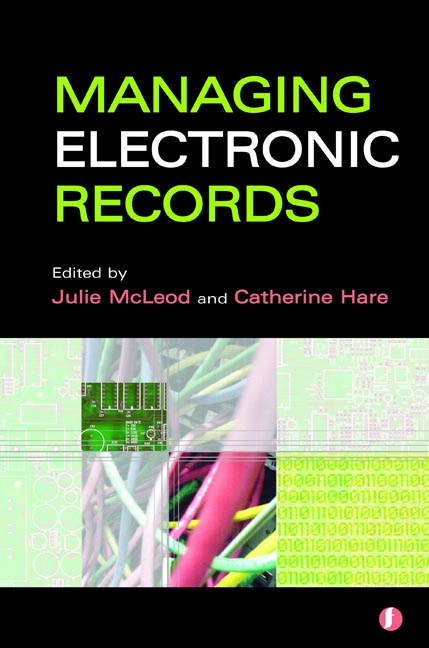Book contents
- Frontmatter
- Contents
- The editors and contributors
- Preface
- 1 The wild frontier ten years on
- 2 The use of standards and models
- 3 Metadata matters
- 4 Digital preservation – ‘the beautiful promise’
- 5 Research in electronic records management
- 6 Technologies for preservation
- 7 Legal issues
- 8 Ethics and electronic recordmaking
- 9 Competencies – the asset that counts most: on developing human talents as a prerequisite for successful EDRM changes
- 10 Records management: two case studies from the French private sector
- 11 Implementing a solution for electronic recordkeeping in the public sector
- 12 Playing the long game – creating and maintaining the links in the value chain
- Index
4 - Digital preservation – ‘the beautiful promise’
Published online by Cambridge University Press: 08 June 2018
- Frontmatter
- Contents
- The editors and contributors
- Preface
- 1 The wild frontier ten years on
- 2 The use of standards and models
- 3 Metadata matters
- 4 Digital preservation – ‘the beautiful promise’
- 5 Research in electronic records management
- 6 Technologies for preservation
- 7 Legal issues
- 8 Ethics and electronic recordmaking
- 9 Competencies – the asset that counts most: on developing human talents as a prerequisite for successful EDRM changes
- 10 Records management: two case studies from the French private sector
- 11 Implementing a solution for electronic recordkeeping in the public sector
- 12 Playing the long game – creating and maintaining the links in the value chain
- Index
Summary
Introduction
How will our grandchildren judge us? Will they remember us as conscientious custodians, who adapted quickly to the needs of the electronic information age, or will they smile forgivingly at museum stores and library shelves filled with mute magnetic media, their contents long past any chance of retrieval? Digital preservation in 2005 stands at a crossroads. Will archivists and librarians forgo the comfort of digitizing their existing holdings and turn instead to the complex but more promising task of saving the ‘new history’, being born digital all around us – seemingly ephemeral but glorious in its potential?
Beginning with an archival fundamental among the seeming anarchy of the information age, there will soon come a time when users stop hitting the print button as a reflex action and storage is only measured in bytes. At this point, will ‘permanent’ retention be replaced by short-term, technologydependent retention? Who is brave enough to even discuss this question with colleagues? Who is measuring this substitution effect – the eventual demise of ‘new’ paper records and their complete replacement by the electronic? And who is making plans to deal with this effectively?
This chapter does not present a detailed technical discussion about methods of digital preservation. These methods are not universally agreed and will need to be subjected to further empirical investigation over the next few years. Instead, the chapter offers a consideration of the purposes and context of digital preservation, followed by some practical advice on setting up a digital preservation business unit within or for an organization that requires such a function. In addition to historical records or library services’ requirements for digital preservation, this advice will also be of use to businesses managing their current records, whether governmental or in the corporate sector. Major changes in legislation with implications for records management, such as Sarbanes-Oxley in the USA (US Congress, 2002) and freedom of information legislation in the UK, mean that managing electronic records across major operating system and utility applications lifecycles has become a necessity for many businesses.
The word ‘record’ is used throughout to denote an electronic object(s); any discussion of intellectual property ownership issues or focus on any particular type of record, whether administrative or published, is largely avoided.
- Type
- Chapter
- Information
- Managing Electronic Records , pp. 50 - 62Publisher: FacetPrint publication year: 2005
- 1
- Cited by



